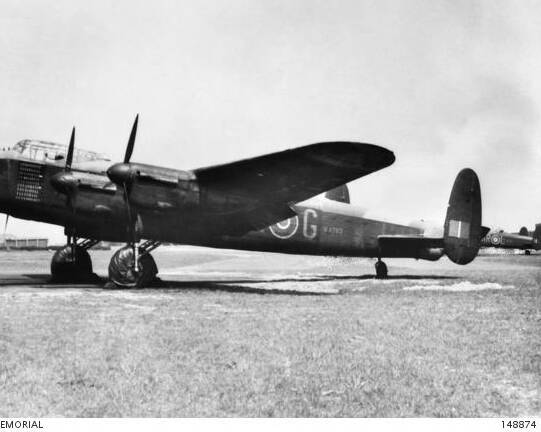
The modern day "descendants" of the Australians who flew bombers over Germany in World War II have visited Canberra to pay tribute - and be inspired.
Members of 460 Squadron were shown around the Lancaster bomber, currently in storage at the Australian War Memorial, which will become the centerpiece of the expanded exhibition when the building work at the memorial is finished.
During the war, the four-engine propeller aircraft flew more than 90 raids over Germany, returning with serious damage on one in three of its missions.
All told, there were 10,000 Australians in Bomber Command and 4100 of them died. The chances of not returning were very high.
"It's incredible to think that it flew over enemy territory so many times. It was severely damaged on 27 missions," Dr Lachlan Grant, historian at the war memorial, said.

Today's members of the same squadron were deeply impressed by the aircraft.
"It demonstrates the degree of sacrifice that was made," Wing Commander Anthony Cullen said.
"The example that our forebears made provides us with a good template, and if we could emulate them, it would be amazing."
Six men who took part in the raids over Germany are still alive, he said. "We keep in touch with them. They are always invited to our functions."
On occasion, people who flew in Lancasters have visited the war memorial's exhibit.
"It was only luck that kept me alive," one of them, RAAF flying officer Leonard Bence, said. He and his comrades bombed munition factories, rail yards and waterways in Germany despite intense bombardment.
"I had a few terrible raids, terrible trips. Got 33 holes one night. But overall I enjoyed it, I really enjoyed," he said.
"Let's face it, the Lancaster was the finest bomber plane in the world at the time, no doubt about it."
The squadron was formed in 1941 as part of Bomber Command under the command of "Bomber" Harris. Australia, New Zealand and Canada provided air crews as well as Britain.
The Australian War Memorial's Lancaster was delivered to 460 Squadron RAAF on October 27, 1942 and was assigned the call sign "G" for George.
Its first mission was on December 6 against the city of Mannheim.
During the next 16 months, its bombing operations included what became a famous raid against the secret German facilities where the V1 and V2 rockets were being developed. This was at the edge of its range because the site at Peenemunde was on the Baltic coast, right at the north east corner of Germany.
The bomber's last mission was against Cologne on April 20, 1944. It was withdrawn from service the next day and then flown to Australia at the end of 1944.
In 1945, it toured eastern Australia to help raise funds for the war effort. At the end of the tour, the Lancaster was delivered to the RAAF base at Canberra, where it rested, exposed to the elements, for ten years.
It will become the star attraction at the new Anzac Hall in the revamped Australian War Memorial.
We've made it a whole lot easier for you to have your say. Our new comment platform requires only one log-in to access articles and to join the discussion on The Canberra Times website. Find out how to register so you can enjoy civil, friendly and engaging discussions. See our moderation policy here.







